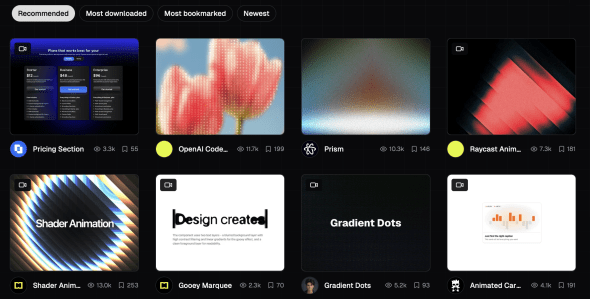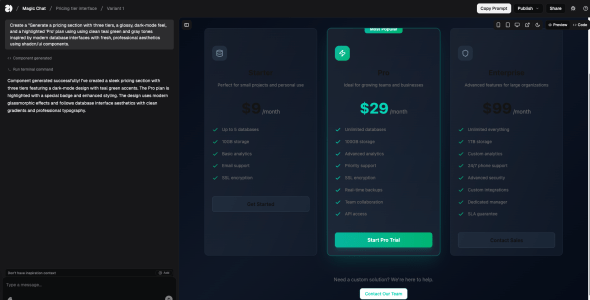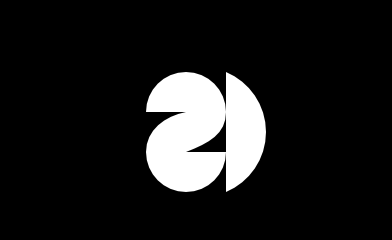21st.dev: AI-Generated UI for Faster Development
21st.dev is a marketplace and open-source registry for user interface (UI) components that uses artificial intelligence. Developed by 21st Labs Inc. and launched in 2024, the platform allows developers to create, share, and monetize reusable UI components built for React, Next.js, and Tailwind CSS.
21st.dev is designed for developers and design engineers who want to speed up application development. Its primary value is to alter the time-consuming and costly workflow of building UI from scratch. By providing a community-driven library of components and an ai ui component generator, the platform simplifies the path from concept to production-ready code.
Best Use Cases for 21st.dev
- Rapid Prototyping for Startups: Startups and small teams can use 21st.dev to quickly assemble functional and visually appealing prototypes. Instead of spending weeks building a design system, they can pull from a library of pre-built components and use the AI to generate elements that match their brand’s look, reducing time-to-market for a minimum viable product (MVP).
- Frontend Development Teams: Development teams in larger organizations can use 21st.dev to standardize their UI components and improve collaboration between designers and developers. The platform acts as a central registry, promoting consistency across different applications while allowing for easy customization and integration, which users cite for its efficiency.
- Freelance Developers and Agencies: Freelancers can deliver quality web applications to clients faster. For instance, a freelance developer building a custom e-commerce site can use this platform to find and implement everything from product display cards to checkout forms, all while confirming the components are modern, responsive, and accessible.
- Design Engineers: This tool is particularly useful for design engineers who work between design and code. They can publish and sell their own reusable components, contributing to the community and creating a passive income stream. The platform’s direct integration with AI coding assistants further improves their workflow.
Accelerated Development: Users report significant time savings, allowing them to build and ship applications faster.
Quality Components: The marketplace offers a broad range of well-designed, modern, and interactive UI components.
AI Vibe-Crafting: The AI feature allows developers to generate component variations that match a specific aesthetic, moving beyond simple copy-and-paste libraries.
Community-Driven Registry: It fosters a community where developers can share, discover, and improve upon UI elements.
Direct Integration: Components are built with current technologies like Radix UI and Tailwind CSS and can be integrated into any React or Next.js project.
Developer Monetization: Allows developers and designers to sell their creations on the marketplace.
Emerging Platform: As a newer tool, its library is still growing compared to more established repositories.
Niche Focus: The tool is focused on the React, Next.js, and Tailwind CSS stack, limiting its utility for developers working with other frameworks.
API Learning Curve: Mastering the AI for generating components may require a slight learning curve for some users.
Potential for Over-reliance: The ease of use might lead junior developers to use pre-built components without understanding the underlying code.
-
AI Component Generation: The platform includes a ui generator ai that creates production-ready UI components from natural language descriptions.
-
Component Marketplace: A searchable registry of reusable UI components, blocks, and templates submitted by the community.
-
Vibe-Crafting Tool: A feature that allows users to find UI inspiration and generate variants based on their taste.
-
Open Source Registry: The core is open source, giving developers full control over the code they implement.
-
Easy Installation: Components can be added to a project with a simple command-line interface command.
-
TypeScript Support: Built with TypeScript, which adds type safety and improves the developer experience.
-
Interactive Previews: Users can see live, interactive previews of components before deciding to use them.
-
Community and Creator Support: The platform is built to foster collaboration and support for those who create and share components.
 21st.dev-Gallery
21st.dev-Gallery
 UI Component Generator
UI Component Generator
Frequently Asked Questions
-
What is 21st.dev?
21st.dev is an AI-powered marketplace and open-source registry for UI components. -
Who should use 21st.dev?
Developers, design engineers, and teams working with React, Next.js, and Tailwind CSS should use 21st.dev. -
How does the pricing and credit system work?
21st.dev offers a free plan with a monthly credit allowance for AI generation. Paid plans provide more credits and features for professional use. -
Can I customize the components from 21st.dev?
Yes, users can customize components because the tool provides the full source code, not just a pre-packaged library file. -
What technologies are required to use 21st.dev components?
A project using React or Next.js with Tailwind CSS is required to use the components.
Tech Pilot’s Verdict on 21st.dev
I’ve been watching AI coding assistants evolve, and my goal in evaluating 21st.dev was to see if it provides a tangible advantage over using a component library like shadcn/ui or a design-to-code tool like Locofy.
First, I tested the core marketplace functionality. I simulated building a dashboard for a SaaS application, needing charts, tables, and stat cards. The 21st.dev library was impressive. I found quality, interactive components that would have taken days to build manually. The integration was simple, a single CLI command pulled the component’s source code directly into my project, which is a major benefit for customizability.
Next, I tested the “vibe-crafting” AI feature. I gave it a prompt: “Generate a pricing section with three tiers, a glossy, dark-mode feel, and a highlighted ‘Pro’ plan.” The performance of the ui generator ai was notable. The results were good, providing a starting point that was about 80% complete. The structure was solid and the styling was consistent. This is where 21st.dev is different; it’s not just a library, but a creative tool.
The pricing seems fair for the value. The free tier is sufficient for small projects, and the paid plans are reasonably priced for professional developers who would see a return on investment through time saved.
Top Alternatives to 21st.dev
-
shadcn/ui: This is the direct inspiration for the component model used by 21st.dev. Shadcn/ui is a collection of reusable components that you copy into your app, giving you full ownership of the code. It is free and open-source but lacks the AI generation features and marketplace of 21st.dev. Shadcn/ui is a better choice for developers who want a simple, non-commercial library without AI assistance.
-
Locofy: Locofy focuses on converting designs from Figma or Adobe XD directly into frontend code. Its main benefit is speeding up the design-to-development handoff. While 21st.dev provides pre-built and AI-generated components, Locofy creates code from a specific design file. Locofy is a better option for teams with a structured, design-first workflow who need to translate specific designs into code.
-
Flowbite: Flowbite is a large open-source library of UI components built with Tailwind CSS. It offers a wide collection of components and supports frameworks like Vue.js and Angular in addition to React. However, it does not have the AI code generation capabilities of 21st.dev. Flowbite is a good choice for developers outside the React stack or those who need a large volume of standard components for free.
Final Verdict
In summary, 21st.dev occupies a specific and useful position in the market. For frontend developers, startups, and teams working within the React and Next.js stack, this ui generator ai is a valuable tool that can speed up development and support creativity. It’s more than a component library; it’s a collaborative platform with useful AI functions.

